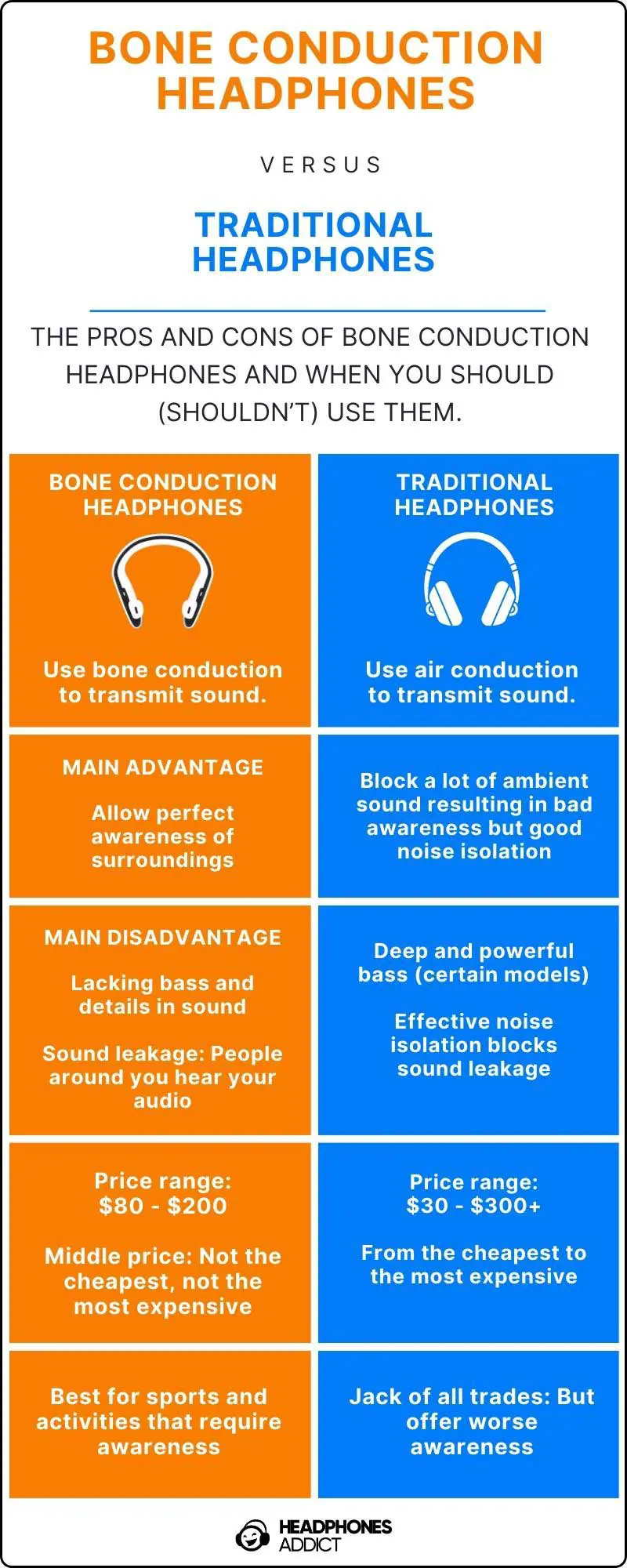Exposing Bone Conduction Headphones: A Buy or Throwaway?
Should you get bone conduction headphones or forget about them? We compare them to traditional headphones and explain their advantages and limitations.
P.S. They’re great for activities, sports, and people with specific hearing impairments.

Key Takeaway
Bone conduction headphones use sound-conductive properties of bones to transmit audio.
Bone conducting headphones leave your ears open, allowing you to hear your surroundings.
They’re ideal for sports and activities that require awareness (running, cycling, etc.)
Limitations: Less bass and more sound leakage.
Bone conduction was discovered in the 1500s, with the first use in 1935 in a bone conduction telephone.
Wissonly Hi Runner is the leading bone-conduction headphone brand.
How Bone Conduction Technology Works
Headphone bone conduction transmits sound directly to the inner ear bypassing the outer and middle ear. Traditional headphones first send the sound through the outer ear before reaching the inner ear.
Normal hearing uses air, while bone conduction skips the air and eardrums.
Sound transmission is a natural property of bone.
In fact, a large part of how you hear your voice is through bones. It’s also why your voice seems different to you than to others (if you record yourself, you’ll sound different).
Bone conduction as a sound transmission method
Bone conduction works on the principle of vibrations.
Typically, when sound waves travel through the air, they create vibrations captured by the external ear, pass through the ear canal, and eventually reach the eardrum. The eardrum then converts these vibrations into electrical signals, which are transmitted to the brain, allowing us to hear sound.
Normal hearing (air conduction) illustration:
Bone conduction takes a different route. Instead of relying on air conduction, bone-conducting headphones use transducers that generate mechanical vibrations. Because they’re touching the bones of the listener’s skull, the sound vibrations travel directly to the Cochlea (inner ear), bypassing the eardrum.
Once Cochlea receives sound vibrations through bone conduction, it converts them into nerve impulses. Then our brains can understand the nerve impulses as sound.
Bone conduction illustration:
The anatomical structure of skull bones sends sound vibrations directly to the Cochlea. For this reason, the transducers of bone conduction headphones are strategically positioned on the temporal bone, ensuring optimal sound conduction.
Comparison with air conduction and how it affects hearing
Bone conduction differs from air conduction, the typical method of sound transmission, in a few aspects:
With air conduction, sound waves travel through the air, enter the outer ear, and reach the eardrum, which then transfers the vibrations to the middle ear and eventually to the Cochlea.
In cases such as hearing loss and specific medical conditions, air conduction may not work.
Bone conduction is an alternative way to hear. It bypasses any blockage or malfunctions in the outer and middle ear.
Also, bone conduction has a unique advantage in terms of environmental awareness.
Traditional headphones and earbuds cover and block the ear canal, preventing awareness of the environment.
On the other hand, bone conduction headphones leave the ears open, making users aware of their surroundings while listening to audio.
This makes them useful for people who want to listen to music during outdoor activities, sports, and work that requires situational awareness.
Advantages of Bone Conduction Headphones
First, here are the advantages of bone conduction headphones:
Perfect awareness when listening to music
People with specific hearing impairments can hear them
Super comfortable and stable
Ideal for sports and activities
Open-ear design allows perfect situational awareness.
Traditional headphones cover and block the ears from environmental sounds. Bone-conducting headphones sit on the sides of the head, leaving the ear canal open.
This allows you to be aware of your surroundings while listening to audio. This is useful for outdoor activities like running, cycling, and walking in crowded streets.
You can listen to music, podcasts, and audiobooks while not compromising your ability to hear important sounds, like traffic, conversations, and alarms.
Bone conduction headphones are beneficial for people with certain hearing impairments
Bone conduction is an alternative for people with conductive hearing loss, single-sided deafness, and for people with in-ear hearing aids. It occurs when sound waves can’t reach the inner ear through an air-conduction path.
Bone-conducting headphones stimulate the Cochlea with bone vibrations by bypassing the outer and middle ear. This allows people with hearing impairments to hear sound clearly and effectively.
So people with hearing impairments in these areas can listen to music and videos. But bone conduction doesn’t work if you have problems with the inner ear (Cochlea) or auditory nerve.
Improved comfort and no ear fatigue
Bone conduction headphones eliminate the need to insert anything into or onto ears. They leave the ears completely free from irritation.
This dramatically improves comfort. Also lowers the chance of ear infection due to prolonged use of in-ear headphones.
Perfect for sports and activities
Bone-conducting headphones are perfect for sports and activities thanks to their open-ear design and high water protection.
The open-ear design allows you complete awareness of your surroundings. This makes them popular among runners, hikers, water sports and cyclists. You can listen to music while keeping a high sense of safety no matter the situation.
These advantages make bone conduction headphones versatile for individuals seeking a unique audio experience.
To summarize, they’re top-notch in:
Comfort
Safety (awareness)
Durability
No other type of headphones is better in these categories.
Read more:5 BEST WIRELESS WORKOUT HEADPHONES IN 2023 (GREAT FOR GYM & OUTDOORS)







